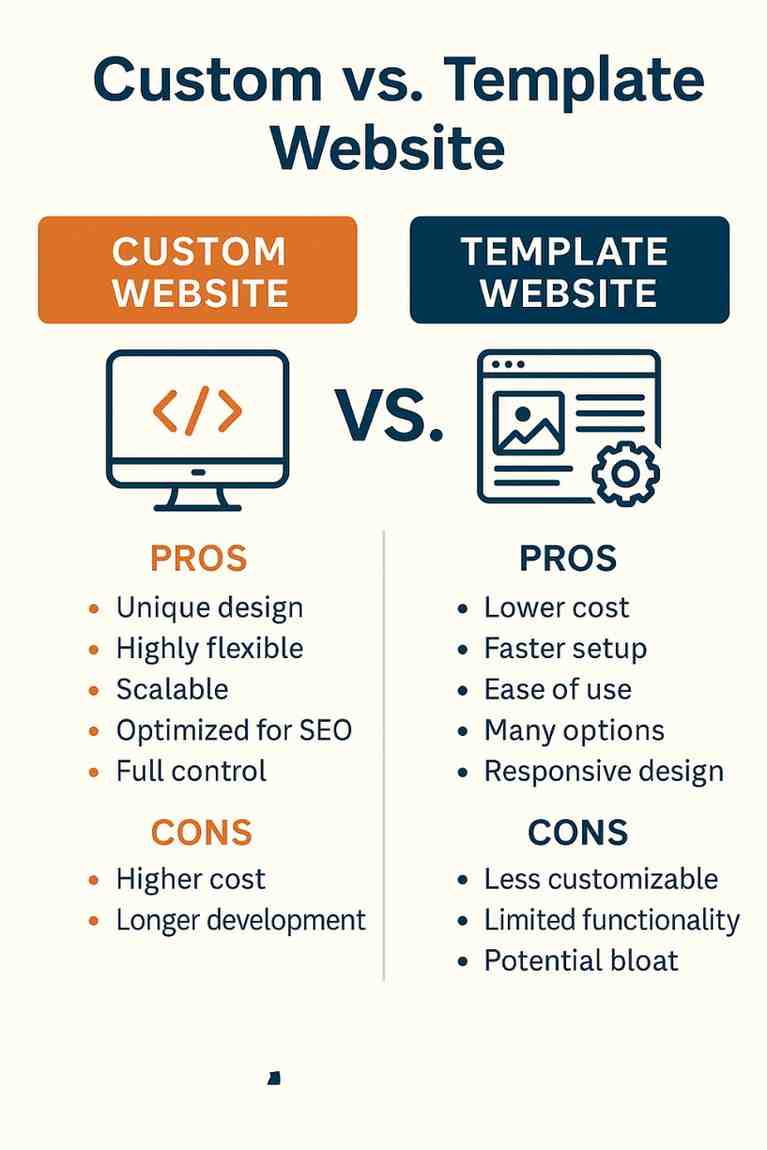Does Your Business Need a Custom Website or a Template? Pros & Cons (2025 Guide)

One of the first questions you'll have when creating or updating your company website is:
"Should I use a ready-made template or have a website built from scratch?"
Everything from cost, scalability, and long-term success to your branding and functionality may be impacted by the choice. In order to make the best choice for your budget, objectives, and industry demands in 2025, this guide will assist you in weighing the advantages and disadvantages of each strategy.
🧱 What’s the Difference?
🔹 Template Website
Pre-made themes, which are frequently found on websites like Squarespace, Wix, and WordPress, are used to create template websites. You can change the basic layout, colours, and content, but the main features and structure remain the same.
🔹 Custom Website
A developer or agency creates a custom website from the ground up using a framework (such as Laravel, React, or Next.js) that is customised to your company's requirements.
✅ Pros & Cons of a Template Website
✔️ Pros:
Affordability
Templates are reasonably priced; the theme and setup typically cost between £50 and £300. ideal for new or early-stage companies.Speed
Launch your website in a matter of days rather than weeks. Because templates are pre-built, deployment is accelerated.Ease of Use
Drag-and-drop builders are included in many templates. For non-technical users, platforms such as WordPress with Elementor make management simple.Plenty of Choices
There are thousands of templates available for every industry, from restaurants to tech startups.Responsive by Default
Most modern templates are mobile-friendly out of the box.
❌ Cons:
Limited Uniqueness
Using the same template, your website might resemble thousands of others. Not the best for branding.Rigid Layouts
You can only do what the theme allows. It might be necessary to hack the code or start over in order to make significant structural or design changes.Performance Issues
Templates may be overloaded with extraneous features or third-party scripts that cause your website to load slowly.SEO Limitations
Unless they are improved with plugins and manual fixes, many templates aren't completely optimised for SEO or performance.Security Concerns
If widely used templates are not adequately updated and secured, hackers may target them.
✅ Pros & Cons of a Custom Website
✔️ Pros:
Tailored to Your Business
Everything is created with your target audience, brand identity, and particular goals in mind, from user flow to design.Scalable
Do you require a reservation system? Online shopping? Integration of CRM? Custom websites can expand and grow with your company.Better Performance
Improved Google Core Web Vitals scores, cleaner user interfaces, and quicker load times are all results of optimised code and structure.Stronger SEO
A competent developer will incorporate markup, meta controls, and an SEO-friendly structure into your website.Full Ownership
Platform restrictions and template licenses don't apply to you. The ecosystem of your website is entirely within your control.
❌ Cons:
Higher Cost
Depending on features and complexity, custom websites usually start at £1,500 to £5,000.Longer Build Time
Design, development, testing, and revisions should take three to eight weeks. Complex builds take longer.Requires Expert Help
Building and maintaining the website will require a qualified developer or agency, which entails continuous expense and dependence.
💼 Which One Is Right for Your Business?
Choose a Template if:
You’re a small business with a limited budget.
You need a site fast (e.g. a brochure site or portfolio).
You don’t need complex functionality.
You’re comfortable with do-it-yourself tools.
Choose a Custom Website if:
Branding and uniqueness are crucial.
You want full control over UX and structure.
You need scalable or complex functionality (e.g. payment systems, user logins, dashboards).
SEO performance and speed are top priorities.
You’re planning for long-term growth.
🛠 Hybrid Option: Customise a Template
Not yet able to afford a complete custom build? Think about a hybrid approach:
Utilise a premium, high-quality template as a starting point, then work with developers to make significant changes. Speed, cost, and brand identity can all be well-balanced with this.
📈 2025 Trends to Keep in Mind
Core Web Vitals: Google favours fast, interactive websites. Custom sites usually score higher.
Mobile-first Indexing: Ensure your site looks great and performs well on smartphones.
Accessibility Compliance: Your site should work for everyone—including those with disabilities.
Headless CMS Growth: For future-proof flexibility, a lot of companies are using Laravel or Strapi with React frontends.
AI Integrations: Custom setups allow more control over adding chatbots, personalisation tools, and data dashboards.
🧠 Conclusion
There isn't a single, universal solution. While custom websites provide experiences that are tailored to your business, templates provide a quick and cost-effective way to get online.
It takes more than just a beautiful website to stand out online in 2025. Making meaningful digital experiences is the goal, and the framework you choose can make or ruin that process.
If in doubt, consult a developer or digital agency that provides both choices and can advise you according to your requirements and expansion goals.
